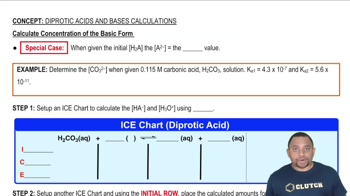The equilibrium 2 NO(𝑔) + Cl2(𝑔) ⇌ 2 NOCl(𝑔) is established at 500.0 K. An equilibrium mixture of the three gases has partial pressures of 0.095 atm, 0.171 atm, and 0.28 atm for NO, Cl2, and NOCl, respectively. (b) If the vessel has a volume of 5.00 L, calculate Kc at this temperature.
Ch.15 - Chemical Equilibrium
Chapter 15, Problem 36
A mixture of 1.374 g of H2 and 70.31 g of Br2 is heated in a 2.00-L vessel at 700 K. These substances react according to H2(g) + Br2(g) ⇌ 2 HBr(g). At equilibrium, the vessel is found to contain 0.566 g of H2. (a) Calculate the equilibrium concentrations of H2, Br2, and HBr.
 Verified step by step guidance
Verified step by step guidance1
Step 1: Convert the initial masses of H2 and Br2 to moles using their molar masses. The molar mass of H2 is approximately 2.02 g/mol, and the molar mass of Br2 is approximately 159.81 g/mol.
Step 2: Calculate the initial concentrations of H2 and Br2 by dividing the moles of each by the volume of the vessel (2.00 L).
Step 3: Determine the change in moles of H2 from the initial state to equilibrium by converting the equilibrium mass of H2 (0.566 g) to moles and subtracting it from the initial moles of H2.
Step 4: Use the stoichiometry of the balanced chemical equation to find the change in moles of Br2 and HBr. Since the reaction is 1:1:2, the change in moles of Br2 will be the same as H2, and the change in moles of HBr will be twice that of H2.
Step 5: Calculate the equilibrium concentrations of H2, Br2, and HBr by adjusting the initial concentrations with the changes calculated in Step 4 and dividing by the volume of the vessel (2.00 L).
Key Concepts
Here are the essential concepts you must grasp in order to answer the question correctly.
Stoichiometry
Stoichiometry is the calculation of reactants and products in chemical reactions based on the balanced chemical equation. In this case, the reaction between hydrogen (H2) and bromine (Br2) to form hydrogen bromide (HBr) follows a 1:1:2 molar ratio. Understanding stoichiometry is essential for determining how much of each substance is consumed or produced at equilibrium.
Recommended video:
Guided course

Stoichiometry Concept
Equilibrium Constant
Chemical equilibrium occurs when the rates of the forward and reverse reactions are equal, resulting in constant concentrations of reactants and products. The equilibrium constant (K) can be used to express the ratio of the concentrations of products to reactants at equilibrium. This concept is crucial for calculating the concentrations of H2, Br2, and HBr in the given reaction.
Recommended video:
Guided course

Equilibrium Constant K
Concentration Calculations
Concentration is defined as the amount of a substance per unit volume of solution, typically expressed in moles per liter (M). To find the equilibrium concentrations of H2, Br2, and HBr, one must convert the masses of the substances into moles and then divide by the volume of the vessel. This step is vital for accurately determining the concentrations at equilibrium.
Recommended video:
Guided course

Calculate Concentration of the Basic Form
Related Practice
Textbook Question
Textbook Question
Phosphorus trichloride gas and chlorine gas react to form phosphorus pentachloride gas: PCl3(𝑔) + Cl2(𝑔) ⇌ PCl5(𝑔). A 7.5-L gas vessel is charged with a mixture of PCl3(𝑔) and Cl2(𝑔), which is allowed to equilibrate at 450 K. At equilibrium the partial pressures of the three gases are 𝑃PCl3 = 0.124 atm, 𝑃Cl2 = 0.157 atm, and 𝑃PCl5 = 1.30 atm. (a) What is the value of 𝐾𝑝 at this temperature?
Textbook Question
A mixture of 0.2000 mol of CO2, 0.1000 mol of H2, and 0.1600 mol of H2O is placed in a 2.000-L vessel. The following equilibrium is established at 500 K: CO2(g) + H2(g) ⇌ CO(g) + H2O(g) (d) Calculate Kc for the reaction.
1
views
